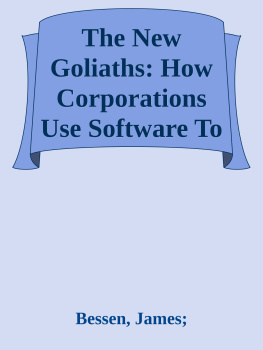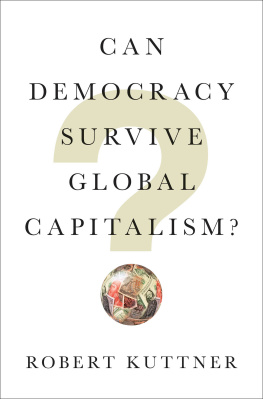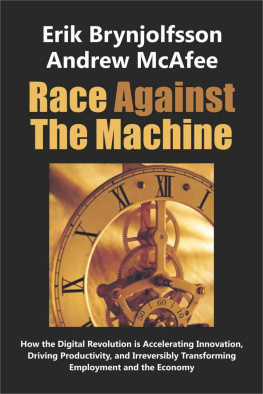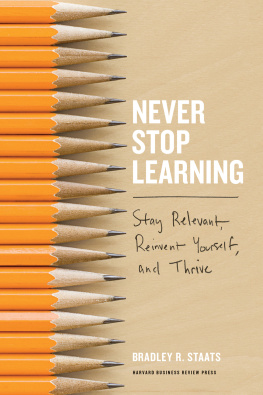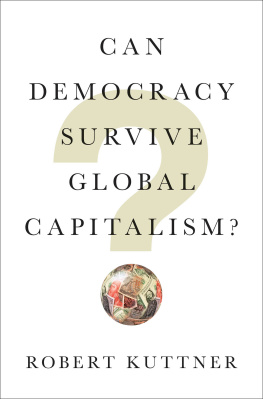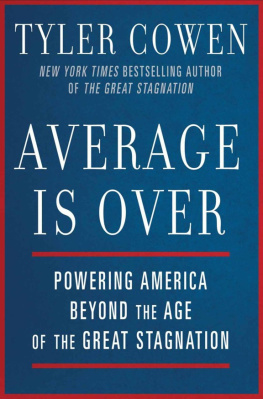LEARNING BY DOING
JAMES BESSEN
Learning by Doing
THE REAL CONNECTION BETWEEN INNOVATION, WAGES, AND WEALTH

Published with assistance from the foundation established in memory of Philip Hamilton McMillan of the Class of 1894, Yale College.
Copyright 2015 by James Bessen.
All rights reserved.
This book may not be reproduced, in whole or in part, including illustrations, in any form (beyond that copying permitted by Sections 107 and 108 of the U.S. Copyright Law and except by reviewers for the public press), without written permission from the publishers.
Yale University Press books may be purchased in quantity for educational, business, or promotional use. For information, please e-mail (U.K. office).
Set in Scala and Scala Sans type by Westchester Publishing Services.
Printed in the United States of America.
Library of Congress Cataloging-in-Publication Data
Bessen, James, 1958
Learning by doing : the real connection between innovation, wages, and wealth / James Bessen.
pages cm
Includes bibliographical references and index.
ISBN 978-0-300-19566-8 (cloth : alk. paper)
1. EmployeesEffect of technological innovations on. 2. WagesEffect of technological innovations on. 3. Skilled labor. 4. Technological innovationsEconomic aspects. 5. Economic development. I. Title.
HD6331.B554 2015
338.064dc23 2014035012
A catalogue record for this book is available from the British Library.
This paper meets the requirements of ANSI/NISO Z39.48-1992 (Permanence of Paper).
10 9 8 7 6 5 4 3 2 1
To Lauren, Neal, and Krzysztof
CONTENTS
ACKNOWLEDGMENTS
THE IDEA FOR THIS BOOK GREW OUT of the dissonance I experienced between the notions of innovation I had picked up in the classroom and my job running a software start-up. As I describe briefly in , I was surprised by the extent of the knowledge that I needed to acquire, as well as the amount our employees and customers needed to learn, in order to put a new technology into production. That struck me as significant and perhaps underappreciated. My curiosity led me to think about learning by doing, why it is important, and what its importance implies. Although that curiosity might not have been the best attribute for a CEO, it has led me on a course of research and study far more extensive than what I anticipated on leaving my company two decades ago and beginning academic research. The consequences of learning by doing also seem more far-reaching than I imagined.
Because my academic career path has been unusual, I am especially grateful to the people who were accepting and encouraging early on. Eric Maskin gave generously of his time and provided strong encouragement. Boyan Jovanovic provided the first airing of some of my thinking on learning by doing. Mike Meurer has been my academic spouse for ten years now, serving as sounding board, guide, critic, cheerleader, devils advocate, and coauthor of Patent Failure and many papers. My actual spouse, Joyce, played a similar role concerning more practical matters through what were occasionally trying times.
Several institutions have been very supportive, especially Boston University School of Law, thanks to Maureen ORourke and Wendy Gordon. I also had brief stints at the Berkman Center at Harvard and at MIT visiting Eric von Hippel. Much of the book was initially written at the University of California at Berkeley, where I was visiting the Berkeley Center for Law and Technology, thanks to Pam Samuelson, Peter Menell, Robert Barr, and Louise Lee.
I owe special thanks to the people who read the first manuscript and provided comments: Joyce, Arthur Boatin, Emily Feinberg, Dan Fetter, Elaine Ford, Joachim Henkel, Brian Kahin, Michael Kimmage, Jeff Kuhn, Tim Lee, Megan MacGarvie, Mike Meurer, Ale Nuvolari, Rob Restuccia, Tim Simcoe, Scott Stern, and Heidi Williams. Please read the final book; it really is much, much better, thanks to your input.
Several people were essential in acquiring data and hands-on knowledge of weaving technology, including Rick Randall at the Lowell Historical National Park and Mike Christiansen at the American Textile History Museum. Tom Brush generously shared payroll data from the Lawrence Company, and the librarians at Baker Library at Harvard provided access to the original payroll registers and other historical records. Research assistants did much of the work of making data meaningful, including John McClelland, Tim Layton, Dan Wilson, and others.
Various people have shared knowledge and provided feedback in informal discussions and as commenters on papers, as editors, as coauthors, and as interviewees. They include Daron Acemoglu, Jim Adams, Philippe Aghion, Bob Allen, David Anderson, Robert Barr, Ernie Berndt, Tom Brush, Xiangdong Chen, Colleen Chien, Greg Clark, Iain Cockburn, Wes Cohen, Diego Comin, Dennis Crouch, Paul David, Joe Farrell, Dan Fetter, Price Fish-back, Lee Fleming, Dominique Foray, Jennifer Ford, Claudia Goldin, Rowena Gray, Tim Guinnane, Bronwyn Hall, Dietmar Harhoff, Bob Hunt, Brian Kahin, Karim Lakhani, Naomi Lamoreaux, David Landes, Tim Layton, Bill Lazonick, Mark Lemley, Larry Lessig, Tim Leunig, David K. Levine, Frank Lewis, Brian Love, John Lyons, Bruce MacDougal, Megan MacGarvie, Christine MacLeod, Peter Menell, Rob Merges, Mike Meurer, Peter Meyer, David Mitch, Petra Moser, David Mowery, John Murray, Ale Nuvolari, Alan Olmstead, David Olson, Kevin ORourke, John Parker, Lucio Picci, Mitch Polinsky, Woody Powell, Cecil Quillen, Arti Rai, Dan Ravicher, Steven Ringer, Michael Risch, Mark Rosenzweig, Pam Samuelson, AnnaLee Saxenian, Mark Schankerman, Mike Scherer, Carl Shapiro, Kathy Strandburg, Talha Syed, Grid Thoma, Stefan Thomke, Peter Thompson, Ross Thomson, Catherine Tucker, John Turner, Bruno van Pottelsberghe, Eric von Hippel, Polk Wagner, John Wallis, Heidi Williams, Jonathan Williams, Susan Wolcott, Brian Wright, Gavin Wright, Jonathan Zittrain, and many other commenters at talks at Ascona, the AEA, Beihang University, the Berkman Center, Boston University, the Center for Economic Studies at the U.S. Bureau of the Census, DRUID, Duke, the Economic History Association, EPIP, the Federal Reserve Banks of Philadelphia and San Francisco, Harvard, John Marshall Law, MIT, the NBER, NYU, PATSTAT, Pisa, Science Po, Seville, SSHA, Stanford, the University of California at Berkeley and Davis, the University of Maryland Baltimore County, the Washington area economic historians, and Yale.
All of this help yielded some papers and some unconnected ideas. Turning it into a book with a coherent focus required the critical additional help of David Miller and Lisa Adams, who also found a publisher; my wonderful editor, Bill Frucht; and an exceptionally helpful anonymous reviewer.
LEARNING BY DOING
Introduction
THE EFFECTS OF NEW TECHNOLOGY are all around us. We use satellites to find our location on maps, and we ask our cell phones for driving directions. Thanks to logistics, inventory management, and flexible manufacturing technologies, our supermarkets carry fifty times as many items as the grocery stores of eighty years ago, and online shopping lets us choose from an even larger cornucopia. Most of us use computers at work that are far more powerful than the computers of just a few decades ago that required large rooms with specialized air-conditioning. We work differently, communicate with each other differently, create differently, and entertain ourselves differentlyall thanks to new technology. Yet there is one place the effects of technology do not appear: our paychecks.
Next page


